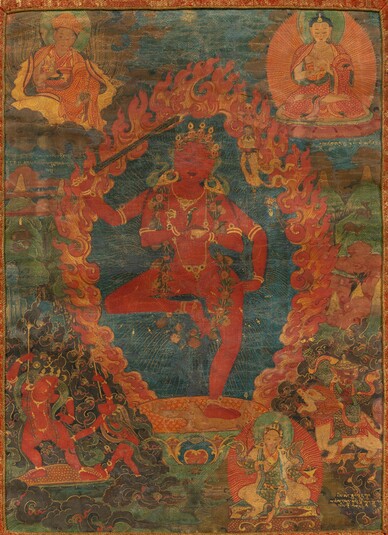
Item: Guhyajnana Dakini - (Four Arms)
| Origin Location | Tibet |
|---|---|
| Date Range | 1700 - 1799 |
| Lineages | Nyingma, Gelug and Buddhist |
| Material | Ground Mineral Pigment on Cotton |
| Collection | Private |
Appearance: Semi-Peaceful
Gender: Female
Guhyajnana Dakini, Guhya Jnana Dakini.
"The Secret Wisdom Dakini, red in colour, with one face and four hands, the two feet in a dancing posture atop a lotus, with a mixed expression of anger and desire. The two rights hands hold a curved knife and sword. The two left hands hold a skullcup filled with blood and a trident, naked, hair hanging loose, adorned with a garland of heads and bones. In the heart is Avalokiteshvara, red in colour, seated on a moon seat, holding a pearl necklace and lotus." (bod brgyud nang bstan lha tshogs chen mo bzhugs so, 2001. ISBN 7-5420-0816-1. Page 318-319).
Lineage of Teachers: Jnana Dakini, Durtropa Chenpo, Dorje Denpa, Lato Marpo, Gyagom Repa, Sanggye Yarjon, Sanggye On, Lha Rinpoche, Lha Wangchug Pal, Ripa Konchog Pal, Togden Konchog Gyaltsen, Lodro Rinchen, Dondrub Rinchen, Chopel Zangpo, Khar Drung, Tsokye Dorje, Kunga Tashi, [Taranata]. (Volume 2, folio 293). (Sadhana text, folio 441-442).
Jeff Watt & Karma Gellek 11-2019
While the Secret Wisdom Dakini seems to have an Indian antecedent, she first comes to light in the Tibetan context during the lifetime of Padmasambhava, the Indian pandit invited by King Trisong Detsen (755-797) to promote Vajrayana Buddhism at the end of the eighth century. According to multiple biographies of the guru, Padmasambhava approached the dakini within her palace with offerings, prostrations and circumambulation. In response the Secret Wisdom Dakini transformed his body into the seed syllable hung and swallowed him, conferring the four empowerments upon him, purifying his body, speech and mind of all defilements and subtle obscurations, equipping him to completely realize his buddha nature. Teachings related to the Secret Wisdom Dakini or ‘Sangwa Yeshe Khandro’ in Tibetan, are believed to have been hidden shortly after Padmasambhava transmitted them to King Trisong Detsen, Princess Yeshe Tsogyal and the great translator Vairotsana. Terdag Lingpa (1646-1714) is credited with discovering some of these teachings. However, it was Lelung Zhepai Dorje (1697-1740) who preserved those teachings and transformed the dakini into an independent meditational deity by dedicating an entire cycle of ritual and meditational practices to her and popularizing them in a non-sectarian fashion. It is Lelung Zhepai Dorje who ostensibly consecrated this painting and whose fingerprints can be seen on the back of the painting. The goddess plays a central role in Terdak Lingpa’s treasure-cycles, and Lelung Zhepai Dorje received and extended the teachings relating to her and Hayagriva. ཐབས་མཆོག་འགྱུར་མེད་ཝཾ་ཡིག་ཟླ་བའི་གཟུགས། ཤེས་རབས་ཨེ་ཡིག་འབར་བའི་ཙནྜ་ལིས། སྦྱངས་པའི་འབར་འཛག་དགའ་བཞིའི་འཁྲུལ་འཁོར་གྱིས། ཁམས་གསུམ་འཁོར་བ་ཐམས་ཅད་ཧྲུལ་པོར་སྦྱོངས། ཅེས་པའང་བཞད་པའི་རྡོ་རྗེས་སོ།
“Unchanging supreme method, The letter WAM in the form of a moon, Wisdom E letter, blazing chandali, Practicing the blazing and dripping, Exercising the four joys; Completely purifying the three realms of existence.” Thus says Shepa’i Dorje. Laura A. Weinstein, 8-2020
Reverse of Painting
Special Features: (Cursive script (Umay))
View other items in the Thematic Set: Buddhist Deity: Guhyajnana Dakini


